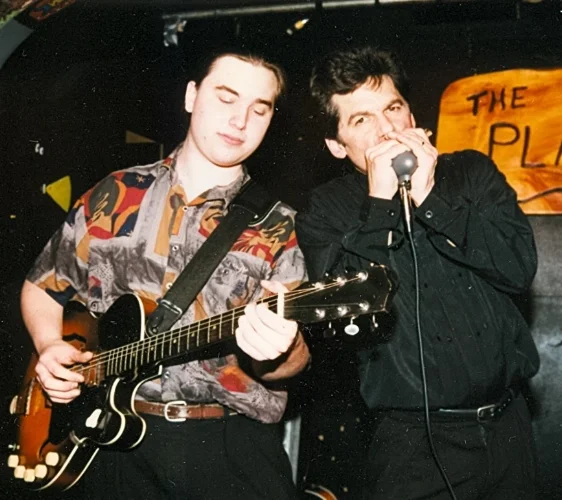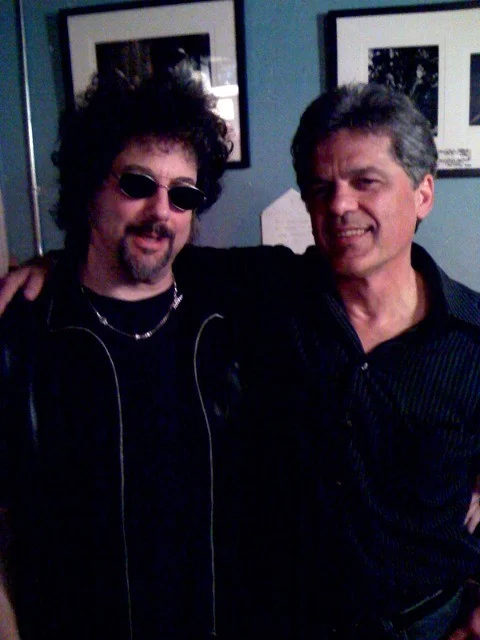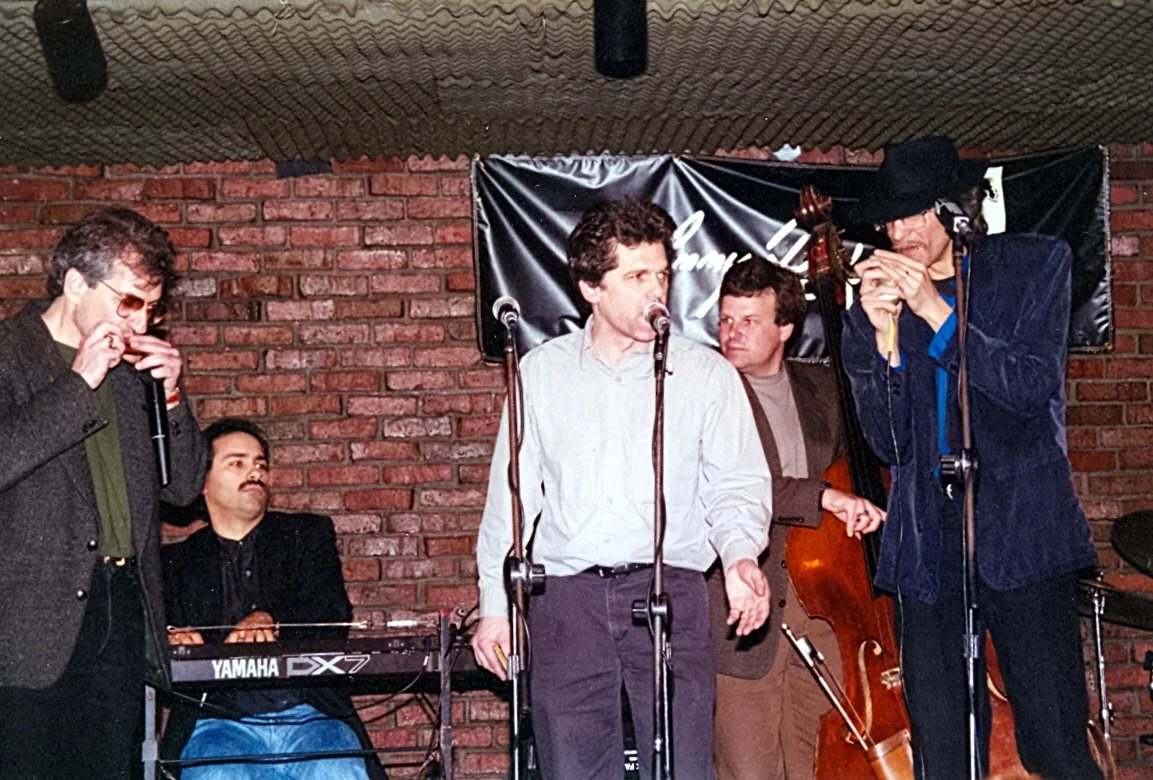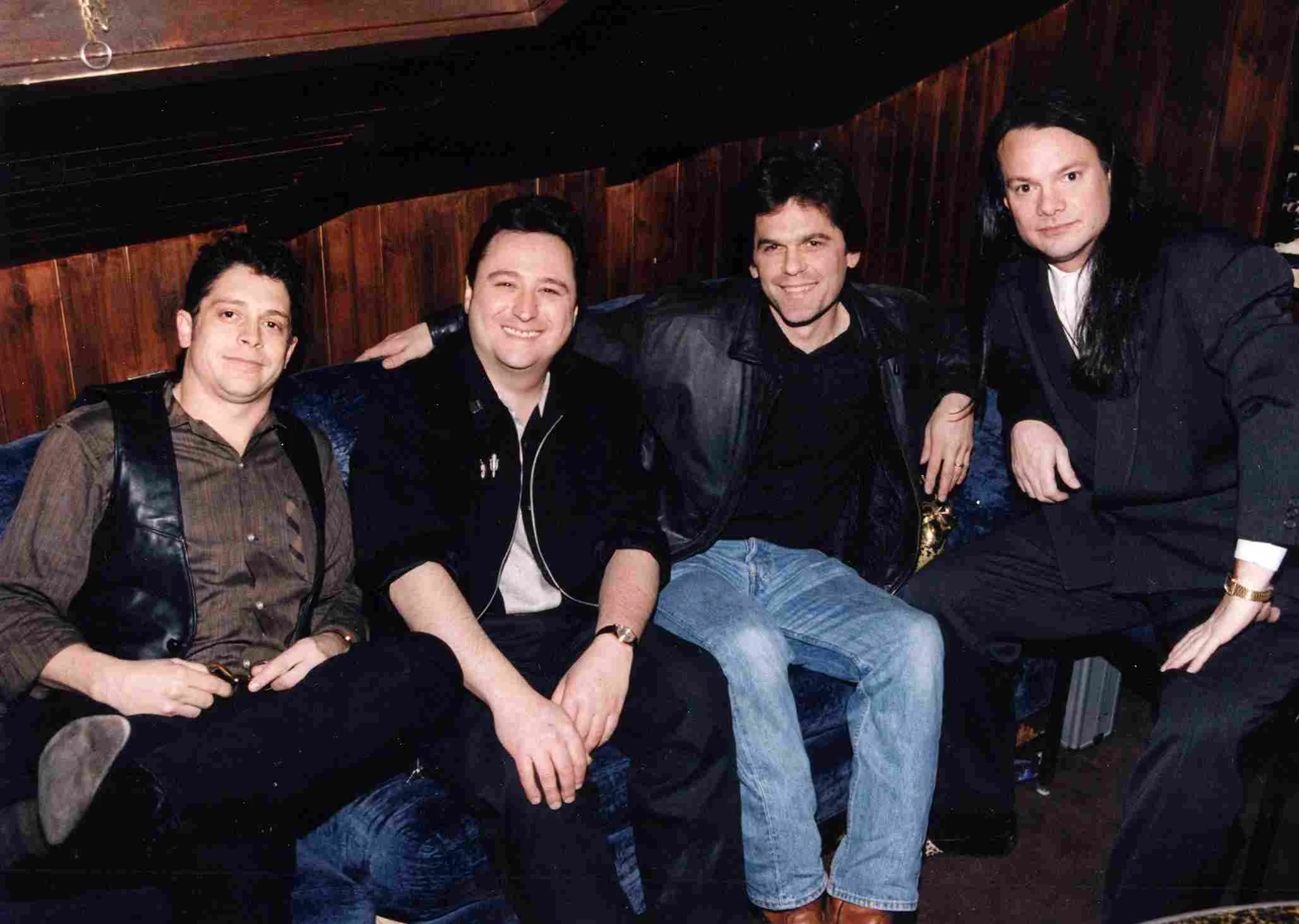Worcester 1990-1996:
harmonicas, harps and heavy breathers
The Diamondbacks: Charlie Baum, Steve Ramsay, me, Dave Clarke
In 1990 my wife got a tenure-track professorship at Holy Cross College and our family moved to Worcester, Massachusetts, where we lived for the next six years. I worked under my own name and also gigged as a member of The Diamondbacks, a really fun and talented group. Guitarist Charlie Baum also worked with Jerry Portnoy, drummer Steve Ramsay had worked with the Charlottesville All Stars and would go on to work with Magic Dick and J Geils in Bluestime, and bassist Dave Clarke was a better harmonica player than I was.
Troy Gonyea and me, the Plantation Club, Worcester, Massachusetts
During my stay in Worcester I had the pleasure of working with guitarist/harmonica player/vocalist Troy Gonyea. I first met Troy when he was sixteen at the blues jam sessions in Worcester; a couple of years later we were gigging together. Everyone who heard Troy at that age knew he was destined for the big time. Jerry Portnoy hired him for a time, and then Kim Wilson recruited him for the Fabulous Thunderbirds. After a few years on the road with Booker T, Troy is now fronting his own band and making a stellar reputation in his own right. Troy is a rare talent who continues to take the blues to new places.
Magic Dick and me
Another great bonus of living in Massachusetts was the chance to get to know Magic Dick, the fabled harp blower in the J Geils Band. Dick was just coming out of semi-retirement at the time; he and Jay just formed Bluestime, which included my Diamondbacks compadre Steve Ramsay on drums. Dick is always looking for new musical challenges and ways to stretch the boundaries of the instrument. Dick and Jay met at engineering school, and Dick is a fascinating, brilliant guy who strikes a beautiful balance between the analytical and the musical in his work as a musician.
Pierre Beauregard, Mike Turk, and Kim Wilson
Kim Wilson formed his first blues band as a side project from the Fabulous Thunderbirds when I was in Massachusetts, and he brought that outfit to the Plantation Club in Worcester. That was when I first met Kim’s great young guitarist, Rusty Zinn. The photo above documents a rare meeting in Worcester of three of my all-time favorite harmonica players. Pierre Beauregard, on the left, is a real master on the diatonic. He and Magic Dick were partners for several years in an effort to bring new tunings for the diatonic harmonica to market. Hearing Pierre play his inventions was an unforgettable experience for a harp player. In the center of the photo is the phenomenal Mike Turk, who for my money is not to be beat as a jazz artist on the chromatic harmonica. I would travel a long ways to hear Mike play the chromatic. Mr. Turk is also a very charming gentleman who appreciates the finer things in life.
Mike Turk, unknown, me, unknown, and Howard Levy at Johnny D's in Summerville
Howard Levy set the harmonica world on its tin ear in the '80s with a radically new approach to playing the diatonic harmonica that has since spawned a coterie of Levy disciples. His talent is almost obscene--Howard is a world-class pianist who has mastered a small orchestra of other instruments as well. Mike Turk brought Howard to Boston for a gig at Johnny D's in Somerville. The two had a day to rehearse, and Mike put together a killer band for the show, which was predictably jaw-dropping. Two of the finest jazz musicians in the world (who both happened to play the harmonica) going toe to toe with each other in an intimate club. It was truly unreal—some of the best music I’ve ever heard. Naturally, I had a front table and was enjoying the music and my third drink when Mike suddenly called me up on stage. I initially panicked, and then took the only possible opening these two geniuses had left me. Neither of these guys sang—their show was completely instrumental—so I called off a swing blues shuffle, sang a couple of verses and honked a little on my diatonic, and then ended my brief stint as the comic relief sandwiched between two geniuses.
Chuck Morris, Ray Norcia, me, and Curtis Salgado at the House of Blues, Cambridge, Massachusetts
East meets West: This is a shot taken upstairs in the band room at the House of Blues in Cambridge, Massachusetts. The guy on the left is a very fine harmonica player (and painter), Chuck Morris. To his left is the one and only Sugar Ray Norcia. Ray has a beautiful voice and he's a monster on the harp--one of the most influential bluesmen of his generation. The long-haired youngster on the right is Eugene, Oregon's Curtis Salgado, one of the greatest blue-eyed-soul singers ever and also a legitimate bad boy on the harmonica. Ray and Curtis both had stints fronting the legendary band Roomful of Blues. When I first moved to Massachusetts I did a weekly gig for a while at the House of Blues with Rick Russell and appeared on a few cuts on a CD of his. This was when I first met and did a few shows with Annie Raines, whose harp playing really knocked me out—and still does.
Kirk Johnson, Charlie McCoy and myself at a book signing event for Harmonicas, Harps and Heavy Breathers at the Davis Kidd bookstore in Nashville (photo by Beth Gwinn)
I was living in Massachusetts when I finished a manuscript for a book on the history of the harmonica, Heavy Breathing. I worked on that project for almost six years off and on. Initially, I just wanted to write a book. Well aware of my tendency to start projects and not finish them, I knew that I had to pick a topic that would sustain me, so the story of the harmonica and its role in all styles of American music was a smart one. I was genuinely interested in the history of this strange little instrument, and the book premise was a great excuse to contact all my favorite players and have them talk with me. I did a ton of research and many, many interviews with the top players still living. The biggest challenge for me was to not let the blues harmonica chapter run away with the book—I wanted to cover the harmonica’s contributions to country, jazz, classical, pop, rock and roll, and movie soundtracks, too.
The book was worth it if only because it was through that project that I met Charlie Leighton. When I was in college, I spent an afternoon at Colony Records in midtown Manhattan and walked away with a copy of George Fields’ album “The Pocket Bach.” That record was astounding to me. George Fields was a native New Yorker who became the first-call harmonica player in Hollywood. The chromatic harmonica on Henry Mancini’s smash hit, “Moon River”?—that’s George’s work. “The Pocket Bach” consists of recordings of Bach pieces performed by Fields on multiple harmonicas and recorded in Fields’ home in Beverly Hills. Until I heard that album I had no idea the harmonica could be used—and used so beautifully—for that kind of music. On the liner notes to the album, Fields noted that he considered a musician in New York City named Charles Leighton to be the great master of the harmonica. Well, if this guy—who is the greatest chromatic player I’ve ever heard—says this other guy is the best, I need to check that other guy out.
In about 1990, when I was still living in Seattle, I headed out to New York City to attend Louis Erlanger’s wedding, so I decided to use that trip to launch the serious work on the book. I went to the Seattle musician’s local and borrowed their copy of the union listings in New York City. I found the phone numbers of a bunch of great harmonica players, including Toots Thielemans, Donny Brooks, Cham-Ber Huang—and Charles Leighton. I called them all up and set up interviews during the time I was in the city.
Charles Leighton
Charlie Leighton lived in a nice apartment filled with his own abstract paintings on 58th Street, right around the corner from Carnegie Hall. I was not really prepared for the interview with him, because I had never hear him play. Charlie turned out to be an incredible gentleman and a very smart and fascinating man. I knew a lot about the great diatonic players in blues, country, and rock roll, but very little about the world of the chromatic players. Charlie knew them all, and I left the interview with him armed with the phone numbers of Jerry Murad, George Fields, Alan Schackner, Stan Harper, and several other great chromatic players. I also flew back to Seattle with a cassette tape that Charlie had handed me as I was leaving—Charlie’s own rendition of Duke Ellington’s “In A Sentimental Mood.”
A week or two later I ran across the cassette and put it on. I think I played it five or six more times that day. Never had I heard a chromatic harmonica sound anything like what Charlie had achieved. His throat vibrato was insanely beautiful. Charlie’s tone is still, to me, the most gorgeous sound ever achieved on the instrument—equal to that of anyone who has ever played a wind instrument. Leighton steered clear of the double stops and chords that characterized the playing of Larry Adler and other artists of the chromatic, preferring single notes. Charlie was one of the first great jazz soloists on the harmonica, and his jazz ideas and phrasing—heavily influenced by his heroes Artie Shaw, Lester Young, and Bobby Hackett—were world class. In later years Charlie recorded some incredible classical pieces, primarily the woodwind-friendly works of Ravel and Debussy, which suited his approach perfectly.
Charlie and I became good friends after I moved to Worcester and was able to visit him in New York City fairly often. Once weekend we drove down to Washington, D.C. together to visit the harmonica collection at the Smithsonian.
I finally finished the manuscript for Heavy Breathing and began contacting literary agents who had a history of signing music books. The rejections started coming in and I wondered about the wisdom of spending so much time and effort on the project. One morning at work I was having multiple conversations with various people at the gas company in Worcester about a bogus bill that they had sent me. The phone rang for the umpteenth time and, assuming it was the gas company once again, I testily answered with “Yeah, what is it this time?” The woman on the other end sounded put out and confused. We finally got it straight that she was a literary agent in New York who was interested in my harmonica book.
It turned out that the call was due to Charlie. Charlie had gotten an audio engineering gig recording corporate-history interviews with senior executives at Conde Nast. He got friendly with one of them, the editor of Town and Country magazine. They got to talking about Charlie’s musical background, and Charlie mentioned that I had interviewed him for my book. The editor told Charlie that he had recently met a literary agent, Robin Straus, at a dinner party and that she had told him that there was a new music book editor at Simon and Schuster and that she wished that she had a music manuscript that she could send him. Charlie had given him my number, he had forwarded it to Robin, and it was Robin who called me that morning at work.
Robin and I sent the manuscript to Simon and Schuster in 1993. They were interested, but I had written the equivalent of a 650-page book on the history of the harmonica, and they wanted something around 350 pages. That meant essentially rewriting the book, but the opportunity to sign with a large publisher like Simon and Schuster was not something to pass up. And trimming the manuscript actually in the end made for a much better book.
A year later, about two weeks before the book was headed to the printer, my editor at Simon and Schuster called to tell me that they needed to change the title. Too many people would buy a book called Heavy Breathing for all the wrong reasons, he said. “Who cares?” I countered, but he then pointed out that the word “harmonica” had to be in the title somewhere to facilitate computer searches. That made a ton of sense. We ended up compromising on a title of “Harmonicas, Harps, and Heavy Breathers,” which was kind of tortured but which accurately described the book.
Simon and Schuster ended up not supporting the book with much of anything in the way of a marketing budget. That was a blow, but I had worked too hard for too long to let the book just die, so I spent the next year doing my own book tour. I put together a pretty amazing launch party at the Rizzoli bookstore in Copley Place in Boston, and over the next few months I did appearances at bookstores around the country, organized financed by me. The bookstores were usually glad to let me host an event, and I would call up the local harmonica heroes and ask them to come and help me out by playing a few tunes after I read a selection from the book.
I released an updated second edition of “Harmonicas, Harps, and Heavy Breathers” in 2000 with the publisher Rowman and Littlefield. The book is still in print, and is also now available in Kindle format.
For information on how to order a copy of “Harmonicas, Harps and Heavy Breathers,” click HERE.
See the “Harmonicas, Harps, and Breathers” section of this web site for more information about the book, excerpts from the book, and photos from the bookstore events.








